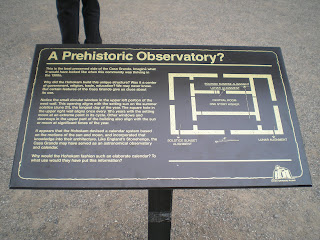Yselta Branch Library, El Paso, TX

From the Coolidge, AZ, Safeway Parking lot: one of the better sunsets I've been able to catch.

Walking to the south I was able to eliminate the parking lot lights -- but not the high TV antennas or power poles.

Hedgehog Cactus at Casa Grand Ruins National Monument.

Named by the first Spaniards (priests) to arrive on the site "Casa Grande." It was originally four stories high, 60 feet long, and weighed 3,000 tons. It was the center of Hohokam settlements which used canals to divert water from the Salt and Gila Rivers to grow corns, beans, squash, tobacco, cotton, and agave.

The Hohokam had no slaves as did the Egyptians pharaols; they carried the caliche [cul-LEE-chee], a mixture of sand, clay, and limestone, into the rising "Great House" on their backs, which was completed about 1350 A.D. However, what is regarded as the Classic Period was over by the early 1400s -- perhaps because of drought.

Each wall of Casa Grande faces a principal direction of the compass. The west wall had a round hole in it which, on 21 Jun, the Summer Soltice, the sun shone through it onto an opposing wall. And the moon shone through a square hole on the west wall approximately every 18.5 years when the moon reached what is call a "lunar standstill"; that is, within two weeks it moved from high in the night sky to low in the morning sky near the horizon. You might call Casa Grande an "American Stonehenge."

Because early visitors to the ruins either defaced or carried off parts of what they found, many portions of the ruins are "off-limits" now.

Believe the docent said the original roof over the ruins was erected in 1935 at a cost which is now a fraction of the cost to paint the roof and its supports.

A plaque which explains the prevalence of Platform Mounds during the Classic Period (c1300-1450).

The plaque explains that ballcourts were very uniform throughout the Hohokam settlements and were similar to those in Central Mexico. The one at Casa Grande was large enough for between 350 and 600 spectators. [Don't know if there were "bookies" who handled wagers on the outcomes of the ballgames, but it wouldn't surprise me.]

The Hohokam were a peaceful group which traded pottery and jewelry for shells from the Gulf of California as well as for Macaws, mirrors, and copper bells from tropical Mexico.

A map of other archeological sites in Arizona as well as state and national parks and monuments.
--
Links:
- Casa Grande Ruins National Monument pages on the U.S. Park Service website
- Wikipedia article on Casa Grande Ruins Natl Monument
- Wikipedia article on Lunar Standstill
M 21 Jan Actual Route: Las Cruces Walmart - Big Lots - Las Cruces Walmart
T 22 Jan Actual Route: Las Cruces Walmart - Dollar Tree - Library - Las Cruces Walmart
W 23 Jan Actual Route: Las Cruces Walmart - Library - Anthony - El Paso Alameda Ave Walmart
Th 24 Jan Actual Route: El Paso Alameda Ave Walmart - Socorro - Ysleta Br Lib - El Paso Alameda Ave Walmart
F 25 Jan Actual Route: El Paso Alameda Ave Walmart - Ysleta Br Lib - Horizon City Town Hall - Socorro - Ysleta Br Lib - El Paso Alameda Ave Walmart
Sa 26 Jan Actual Route: El Paso Alameda Ave Walmart - Ysleta Br Lib - El Paso Alameda Ave Walmart
Su 27 Jan Actual Route: El Paso Alameda Ave Walmart - Ysleta Br Lib - El Paso Alameda Ave Walmart
M 28 Jan Actual Route: El Paso Alameda Ave Walmart - Dollar Tree - Ysleta Br Lib - El Paso Alameda Ave Walmart
T 29 Jan Actual Route: El Paso Alameda Ave Walmart - Ysleta Br Lib - El Paso Alameda Ave Walmart
W 30 Jan Route: El Paso Alameda Ave Walmart - Ysleta Br Lib - Socorro P.O.
--
Finding Campgrounds:
- RV Campgrounds from TrailerLifeDirectory.com
- Family Camping Directories from Woodalls.com
- Free campsites website
- Info on finding BLM Campgrounds


No comments:
Post a Comment